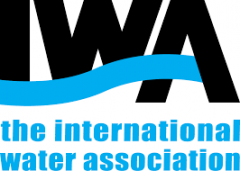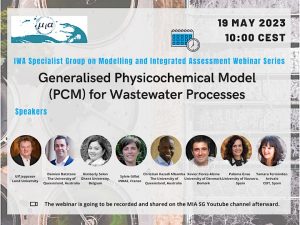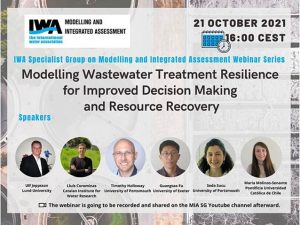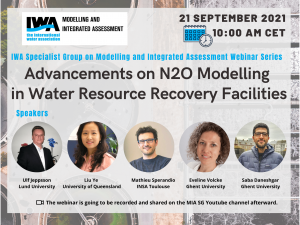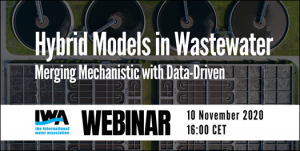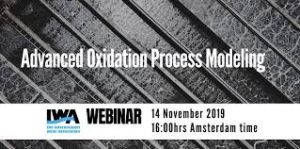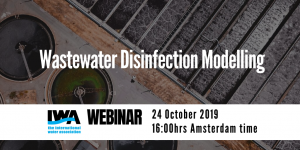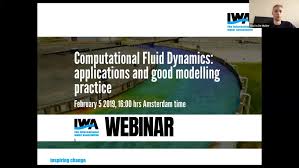Webinars
- Water Resource Recovery Facilities Soft Sensors – It All Starts With Process Knowledge
- Good coding practice in WRRF modelling: Hands-on session
- Bridging the gap between the water reuse community and water treatment model developers
- Using CFD modeling to enhance wastewater treatment processes
- Generalised Physicochemical Model (PCM) for Wastewater Processes
- Modelling tools for water sensitive urban planning
- Modelling of phototrophic systems for resource recovery
- Modelling greenhouse gas emissions from urban wastewater systems: State-of-the-art and beyond
- The incorporation of risk and uncertainty in mathematical models to aid the design and operations of WRRF
- State-of-the-art modelling on anaerobic mixed-culture fermentation
- State-of-the-art in anaerobic digestion modelling
- Modelling wastewater treatment resilience for improved decision making and resource recovery
- Advancements on N2O modelling in water resource recovery facilities
- Hybrid models in wastewater: merging mechanistic with data-driven
- Advanced Oxidation of Water and Wastewater: From Fundamentals to Advanced Modelling and Process Control
- Disinfection modelling
- Computational Fluid Dynamics: applications and good modelling practice
- New advances in Enhanced Biological Phosphorus Removal (EBPR) Modelling
- Modelling Resource Recovery: State of the art and future challenges
- Modelling and Integrated assessment: Overcoming data issues and barriers to integrated modelling in practice
Water Resource Recovery Facilities Soft Sensors – It All Starts With Process Knowledge
Feb 25, 2025, 3:00 pm – 4.30 pm in CET
The webinar will encompass two presentations and a Q&A session. After a welcome and introduction into soft sensor creation and usage, the webinar will have 2 presentations on soft sensor applications showing different case studies. The first will address how soft sensors and diagnostic tools can be used to guide experts through GHG studies to better understand the plant specific drivers of N2O emissions and how to identify control handles for mitigation measures. The second presentation is focused on the development of an influent soft sensor for risk assessment and mitigation. Both of these presentations will be used to highlight the importance of process knowledge as well as pre and post sensor data diagnostics to ensure the accuracy and validity of any sensor calculations. A final Q&A discussion will summarize the day and allow for a broader discussion. Title of the two presentations: 1) The path is the goal – Tools to guide N2O mitigation; 2) All paths start in the sewer: variable influent characterization through sewer modelling.
Video available here.
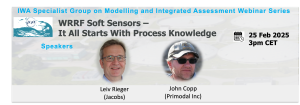
Good coding practice in WRRF modelling: Hands-on session
Feb 5, 2024, 4:00 pm – 5.30 pm in CET
Good Coding Practice In WRRF Modelling: Hands-On Session On How To Version Control With Git And Work With Python Virtual Environments. The IWA Hybrid modelling working group aimed to promote good coding practices for water resource recovery facilities (WRRF). This webinar covered the fundamentals of version control with Git and Python virtual environments, emphasizing the practical aspects through hands-on examples. Participants gained insights into effective coding practices for WRRF modelling, understanding the importance of version control, and leveraging Git for efficient collaboration. The session also explored the benefits of managing packages within virtual environments, with a demonstration using PeePyPoo.py. The hands-on experience also sparks ideas to ease practical implementations.
Documents available:
- Slides
- Handout: PeePyPoo
- Info on Git
- ASM Example
- Video

Bridging the gap between the water reuse community and water treatment model developers
Jan 31, 2024, 3:00 pm – 4.30 pm in CET
The WR and MIA specialist groups joined forces in this webinar to boost interaction and innovation in the pressing water reuse topic focusing on secondary effluent. This webinar wanted to bridge the gap between specialists in water reuse and water treatment modelling to drive interaction and boost innovation in the field. Examples of the current experiences and challenges of the Water Reuse community in managing secondary effluent streams are provided and followed by examples of the available models. This sets the scene for possible model integration or the next model development needs, as well as spark ideas to ease practical implementations.
The webinar’s scope is the following:
i) to make aware the water reuse community about the available modelling tools and how they can boost implementation and advancements
ii) to make aware the modelling community of the gaps that can drive the next model developments
The slides are available here.
The video is available here.
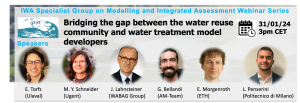
Using CFD modeling to enhance wastewater treatment processes
Dec 14, 2023, 3:00 pm – 4.30 pm in CET
Computational fluid dynamics (CFD) (3D flow modelling) has seen a steady and rapid adoption in wastewater treatment and resource recovery field over the last three decades. The IWA working group on CFD modelling has summarized the generally accepted state of the art for current modelling, as well as identified current research needs and knowledge gaps for the next modelling frontiers in: CFD Modelling for Wastewater Treatment Processes. This presentation will review key modelling applications and facilitate a dialog for developing future applications. Five topics walking through the modelling development over time and through the treatment process will be covered:
- CFD background, modeling practice
- Secondary process (mixing)
- Sedimentation
- Disinfection
- Digestion
- CFD as a supportive tool for other modelling approaches
These applications are all being used to enhance treatment processes.
The slides are available here. The video is available here.
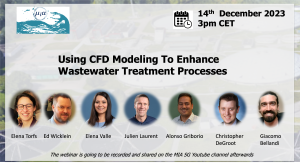
Generalised Physicochemical Model (PCM) for Wastewater Processes
May 19, 2023, 10:00 am – 11:30 am in CET
Physicochemical reactions are those which occur spontaneously in conjunction with biochemical processes. These have received limited attention in biochemical reference models, though they have a strong impact on biochemical reactions, as well as directly describing processes such as gas transfer, precipitation, and metal species oxidation and reduction. An effective physicochemical model is critical to wastewater treatment modelling, both at a unit, and plant-wide level.
In this webinar, a general overview on the concept and aspects of physicochemical reactions and their modelling will be presented. The theory of aquatic chemistry as applied to wastewater processes will be described, including aqueous phase equilibria (acid-base equilibria) and the non-ideality due to presence of ions. The theory and modelling of gas-liquid transfer during wastewater treatment will also be tackled. Precipitation modelling will also be discussed, especially focusing on common particulate compounds formed during wastewater treatment such as those formed by calcium, iron, aluminium, carbonates, phosphates and sulfides. Finally, two examples will be given of the plant-wide applications, both industrial and domestic wastewater treatment, of these advanced physicochemical models.
AGENDA
- Welcome and Introduction to MIA SG and introduction of the Webinar (Ulf Jeppsson)
- Introduction to the webinar topic (Damien Batstone, The University of Queensland, Australia)
- Aqueous phase chemistry (Kimberly Solon, Gent University, Belgium)
- Gas-liquid transfer (Sylvie Gillot, INRAE, Villeurbanne, France)
- Precipitation (Christian Kazadi Mbamba, The University of Queensland, Australia)
- PCM applied plant-wide (Case 1) (Xavier Flores-Alsina, Technical University of Denmark, Denmark)
- PCM applied plant-wide (Case 2) (Paloma Grau, CEIT &University of Navarra, Spain, & Tamara Fernández-Arévalo, CEIT, Spain
- Q&A session (Moderator: Damien Batstone)
TARGET AUDIENCE
Modellers and practitioners: consultants, researchers, students, software developers, plant managers/operators of water resource recovery facilities.
DOCUMENTS
Modelling tools for water sensitive urban planning
April 13, 2023, 3:pm – 4:30 pm in CET
Good water management can make cities healthier places to live, resilient toward climate change and more sustainable overall. Placing water at the core of the city’s urban planning and investments creates a strong foundation for sustainable growth. This webinar aims at presenting and discussing modeling and integrated assessment tools for urban planning that include water as one the relevant components. The first presentation demonstrates an integration of different modeling principles across urban water, ecology and climatology to support sustainable sponge city planning and design. The second, presents an integrated modeling framework to forecast how regional spatial planning affects the viability of building-scale alternative water supply systems. The third presentation is related to the automated design of reclaimed water networks in cities.
AGENDA
- Welcome and Introduction to MIA SG and introduction of the Webinar (Ulf Jeppsson)
- Introduction to modelling and integrated assessment tools for water sensitive urban planning (Nataša Atanasova, University of Ljubljana)
- A palette of modelling to support a planning narrative for multi-functional Blue Green Infrastructures (Peter M. Bach, Eawag / ETH Zurich)
- An integrated modelling framework to forecast how regional spatial planning affects the viability of building-scale alternative water supply systems (Tony Hargreaves, University of Birmingham)
- Optimal design of water reuse networks in cities: decision support tool development and testing (David Martínez, ICRA (Catalan Institute for Water Research)/UdG (University of Girona))
- Q&A session
TARGET AUDIENCE
Urban planners, consultants, academics and modelers with interest in city-wide modelling

Modelling of phototrophic systems for resource recovery
Dec 21, 2022, 3:pm – 4:30 pm in CET
Renowned experts on the topic present the state-of-the-art in modelling microalgae-based processes for resource recovery, with a particular focus on light distribution and availability. Recent models for phototrophic bacteria are also presented and discussed.
AGENDA
- Welcome and Introduction to MIA SG and introduction of the Webinar (Ulf Jeppsson)
- Microalgae based nutrients recycling processes (Francisco Gabriel Acién Fernández)
- Algae-bacteria systems for nitrogen recovery and biomass production: promises and challenges through a modelling approach (Francesca Casagli)
- Modeling light distribution in photobioreactors and its impact on algal growth (Borja Valverde-Pérez)
- Modelling outdoors systems based on Purple Phototrophic Bacteria for resource recovery (Gabriel Capson-Tojo)
- Q&A session
TARGET AUDIENCE
Process modelers, design engineers, utility managers, and technologists, consultants, academics and modelers with interest in carbon footprint mitigation of WRRFs.
DOCUMENTS
Slides and Q&A
Modelling greenhouse gas emissions from urban wastewater systems: State-of-the-art and beyond
Nov 21, 2022, 10:30 AM – 12:30 PM in CET
EVENT DESCRIPTION
MIA specialist group webinar series is continuing with the webinar on Modelling greenhouse gas emissions from urban wastewater systems: State-of-the-art and beyond. This webinar is coorganized with the Instrumentation, Control and Automation Specialist Group (ICA).
AGENDA
- Welcome and Introduction to MIA SG and introduction of the Webinar (by Ulf Jeppsson, Liu Ye)
- Modelling of CH4 emission from sewers: development and application (Keshab Sharma)
- The state-of-the-art of N2O mechanistic model and its full-scale application (Mathieu Sperandio)
- Full 3D simulation of N2O production and emission for root cause analysis, enhancement of measurement campaigns and virtual mitigation strategy testing(Wim Audenaert)
- Benchmarking GHG emissions in water resource recovery facilities: old, new and future perspectives(Xavier Flores Alsina)
- Using AI and machine learning for accounting of, reducing, and monitoring wastewater N2O process emissions (Jose Porro)
- Q&A session
TARGET AUDIENCE
Process modelers, design engineers, utility personnel, academics
DOCUMENTS
Slides
Video

The incorporation of risk and uncertainty in mathematical models to aid the design and operations of WRRF
June 8, 2022, 4:00 PM in CEST
EVENT DESCRIPTION
In the field of wastewater treatment, in spite of many advances over the past 30 years, we are still using design approaches that imply that we work in a well-defined, stationary environment. We typically account for the unpredictable conditions our plant encounter by incorporating generous safety factors in our designs. This often results in overdesigned or inefficient plants. In the current regulatory environment of extremely low effluent nutrient standards, cost pressures, climate change, and energy optimization, a new design approach is required that provides us with an understanding of what are the main sources of uncertainty and quantifies the risk of non-compliance.
The IWA/WEF Design and Operations Uncertainty Task Group (DOUT Group) has been working on the explicit integration of uncertainty in the field of wastewater treatment, for the past 12 years. The group has recently published its Scientific and Technical Report.
This webinar presents the findings of the DOUT Group. The group has presented the key elements of the STR, including such considerations as contract delivery mechanisms and stakeholder perspectives. This webinar focuses on method that we can apply now to include uncertainty analysis in our projects. Specifically, how to identify project specific sources of uncertainty and prioritize them, use of dynamic models to explicitly account for variability, how to incorporate statistical descriptions of major model inputs, how to translate safety factors to Probability Density Functions and how to express model results in terms of statistical watershed criteria.
AGENDA
- Welcome and Introduction to MIA SG (by Ulf Jeppsson)
- Introduction to the Webinar and motivation behind the DOUT initiative (Lina Belia)
- Introducing the principles of uncertainty evaluation (Lorenzo Benedetti)
- Key elements of the DOUT uncertainty analysis framework (Lina Belia)
- Steady-state case study (Bruce Johnson)
- Dynamic case study (Peter Vanrolleghem)
- DOUT perspectives (Marc Neumann)
- 30′ Q&A session
TARGET AUDIENCE
Process modelers, design engineers, utility personnel, academics
SLIDES & VIDEO
Slides.
Access to the video
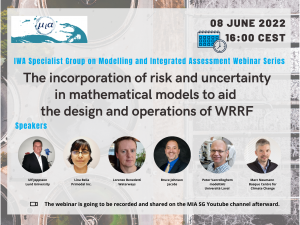
State-of-the-art modelling on anaerobic mixed-culture fermentation
March 31st, 2022, 3:00 PM in CEST
EVENT DESCRIPTION
Webinar on anaerobic mixed-culture fermentation. The state-of-the-art was described by means of three presentations.
AGENDA
- Welcome and Introduction to MIA SG (by Ulf Jeppsson, Lund University)
- Introduction to the webinar (Robbert Kleereebezem, Delft University of Technology)
- Presentation by Alberte Regueira (Universidade de Santiago de Compostela)
- Presentation by Adam Kovalowszki (DTU Environment)
- presentation by Matthew Scarborough (University of Vermont)
- 30min Q&A session (moderator Robbert Kleerebezem)
TARGET AUDIENCE
Modellers
DOCUMENTS
Slides
Video
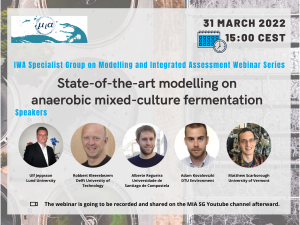
State-of-the-art in anaerobic digestion modelling
Nov 22, 2021 9:00 AM in CET
EVENT DESCRIPTION
Anaerobic digestion (AD) is a key technology in wastewater/waste treatment and valorisation facilities. AD has been used for decades to reduce the volume of sewage sludge from WWTPs, transforming it into biogas (usually recovered as energy via cogeneration) and into a nutrient-rich effluent (digestate). Novel developments in the field, and public policies favoring its implementation, are causing a substantial increase in the number of AD plants worldwide. Within this expansion, the variety of organic streams to be valorised via AD is increasing rapidly. Being AD a mature technology, AD modelling is a well-established field, with the IWA ADM1 being the most well-known and applied model. In the last few years, the increasing complexity of WWTPs (together with the paradigm change towards waste resource recovery facilities) and the expanding AD applications, have called for the development of new models, as well as the modification of existing ones. This webinar aims to:
- present the current state of AD;
- present the state-of-the-art in AD modelling (focused on the ADM1 and its most recent modifications);
- discuss the current state of AD control strategies, and how they will be crucial for the optimisation of AD plants.
TARGET AUDIENCE
Engineers designing and working with AD plants, process modellers (including AD modelling and integrated modelling of WWTPs where AD of sludge is present), process scientists researching AD, developers of model-based decision support systems for AD reactors, plant operators, researchers/engineering working on AD plant monitoring, control and optimisation.
AGENDA & SPEAKERS
-
- Introduction to MIA SG and the Webinar: Ulf Jeppsson, Lund University
- Introduction to ICA SG and the Webinar: Paul Juan Garcia, Atkins Global
- Summary of the seminar “Anarobic digestion: Quo vadis?”: Raul Muñoz, University of Valladolid
- Introduction to the IWA ADM1 model: Damien Batstone, The University of Queensland
- Recent modifications and adaptations of the ADM1: Xavier Flores-Alsina, Technical University of Denmark
- AD modelling and control: history and state-of-art: Jean-Philippe Steyer, INRAE-LBE
- Q&A Discussion: Angel Robles, University of Valencia
- Video
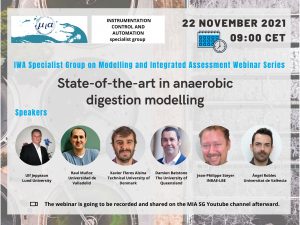
Modelling wastewater treatment resilience for improved decision making and resource recovery
Oct 21, 2021 4:00 PM in CEST
EVENT DESCRIPTION
Many decision-making levels are made for wastewater treatment processes, from high-level planning to the operational worker maintaining wastewater treatment assets. Modelling outputs for decision making at both levels require very different approaches, particularly when innovative or novel processes are used for resource recovery. At a process engineering level, resilience and interventions are managed through real instrument data.
This webinar aims to present:
- The use of conventional biological modelling methods, and real instrument data to charecterise WWTP resilience and the limitations of modelling resilience of wastewater treatment processes and infrastructure.
- The challenge of modelling decisions at the wastewater plant level and high-level decision-makers when considering the recovery of resources from wastewater
- Novel modelling methodology for the visual representation of resilience in an interoperable format
TARGET AUDIENCE
Asset resilience specialists, asset managers, process engineers, process modellers, process scientists, data visualisation specialists, decision modelling specialists.
AGENDA & SPEAKERS
-
- Introduction to MIA SG and the Webinar: Ulf Jeppsson, Lund University
- Coupling conventional modelling with resilience theory for improved operational decision making: Timothy Holloway, University of Portsmouth
- Global resilience analysis for urban wastewater systems: Guangtao Fu, University of Exeter
- Modelling optimal process selection for resource recovery from urban wastewater: NEREUS Multi-criteria Decision Support Tool: Seda Sucu, University of Portsmouth
- Q&A Discussion: Maria Molinos-Senante, Pontificia Universidad Católica de Chile
Advancements on N2O modelling in water resource recovery facilities
Sept 21, 2021 10:00 AM in CEST
TARGET AUDIENCE
Process modelers, utility managers, and technologists, consultants, academics and modelers with interest in carbon footprint mitigation of WRRFs.
DESCRIPTION
Wastewater treatment plants are large contributors to greenhouse gas (GHG) emissions. This comprises both direct and indirect emissions of carbon dioxide (CO2), methane (CH4), and nitrous oxide (N2O). Direct emissions are mainly related to the biological treatment processes. N2O emitted during nitrification/denitrification stages is the most significant direct form of emission while indirect emission is mainly associated with the energy consumption of the plant for which aeration is one of the largest contributors. Mathematical modelling is a widely used tool for the optimization of wastewater treatment plants, mostly in terms of effluent qualities. Only recently the focus of this has been extended to include carbon footprint minimization targets. However, the question remains to which extent models are useful to evaluate, predict and/or mitigate N2O emissions from wastewater treatment processes. In this regard, the IWA Task Group on GHG Emission has a broad objective of understanding and modelling the processes responsible for major contributions to GHG emissions in WRRFs and sewer networks. In this webinar, we are focusing on the history and state-of-the-art studies on N2O modelling as well as recent advancements in the use of mathematical modelling for prediction of N2O emissions in WRRFs and how models can help plant managers in adopting appropriate control and mitigation strategies.
SPEAKERS
-
-
- Introduction to MIA SG and the Webinar: Ulf Jeppsson, Lund University, Sweden & Liu Ye, University of Queensland, Australia.
- History and state of the art of N2O modelling: Mathieu Sperandio, INSA Toulouse, France
- Potential of N2O emission models for full-scale applications: Eveline Volcke, Ghent University, Belgium
- LESSWATT: model-based protocol for mitigation of N2O emission of WRRFs: Saba Daneshgar, Ghent University, Belgium
-
Hybrid models in wastewater: merging mechanistic with data-driven
Nov 10, 2020 4:00 PM in CET
TARGET AUDIENCE
Process modelers, Utility managers, and technologists, consultants, academics and modelers with interest in data science.
DESCRIPTION
Recent literature shows examples of modelling approaches for the integrated urban wastewater system (UWS) operation and asset management. Such examples range from classical theory-based approaches, using mechanistic or empirical knowledge, to theory-free data-driven models using big data.
On one hand, mechanistic models have been extensively used for process design and optimization. However, building the perfect mechanistic model is only possible for the simplest systems, consequently not for biological processes. The resulting limited prediction capability is a limiting factor in using them for real-time decision-making. On the other hand, “pure” big data models exist but remain isolated initiatives in the academic sector.
The close integration of mechanistic models with Big Data processing and learning techniques has the potential to transform how the day-to-day integrated operation of UWS is currently being done.
In this webinar, we will showcase the potential of hybridized mechanistic and data-driven models in the wastewater sector by presenting three existing initiatives that are working towards integrating both paradigms into hybrid models.
The duration of this webinar will be 60 minutes.
LEARNING OBJECTIVES
The participants will learn about:
-
-
- Understanding the advantages and drawbacks of mechanistic and data-driven models,
- Getting familiar with model hybridization through practical examples, combining mechanistic and data-driven models to leverage the strength of both approaches.
-
KEY MESSAGES
-
-
- Mechanistic and data-driven models have both their advantages and drawbacks. Neither of them can tackle all the modelling challenges of the future.
- Combining mechanistic and data-driven models allows to leverage the strength of both approaches
-
HOST
Kris Villez, Oak Ridge National Laboratory, USA
SCHEDULE
4.00 pm – MIA SG introduction and Objectives of the Webinar
(Welcome note by Ulf Jeppsson and Kris Villez)
4.10 pm – Water resource recovery facility (WRRF) influent generator model for flow rate and quality prediction based on a data-driven methodology (Speaker: Feiyi Li – ModelEAU, Univ Laval, Quebec, Canada )
4.20 pm – Hyperparameter optimized deep learning for soft sensing the hard-to-measure wastewater information (Speaker: Dr. Junjie Zhu – Princeton University, USA)
4.30 pm – Integrated hybrid modelling of WRRFs by coupling mechanistic and data-driven ODE models (Speakers: Ward Quaghebeur and Bram De Jaegher – BIOMATH – Ghent University, Belgium)
4:40 pm – Q&A session (Moderator: Kris Villez)
5:00 pm – End
Advanced Oxidation of Water and Wastewater: From Fundamentals to Advanced Modelling and Process Control
Nov 14, 2019 4:00 PM in CEST
TARGET AUDIENCE
Utility managers and technologists, consultants, WRRF and drinking water plant designers, as well as academics and modellers with interest in advanced oxidation applied to water and wastewater.
DESCRIPTION
-
-
- Advanced tools are available to support AOP design
- When multiple design objectives are to be met, process dynamics must be taken into account and appropriately controlled;
- Risk-based methodologies are being developed in order to move from a deterministic to a probabilistic integrated AOPs design framework
-
The duration of this webinar is 60 minutes.
LEARNING OBJECTIVES
The participants learn about:
-
-
- Main modelling methodologies for AOP design, optimization and scale-up
- Established integrated modelling frameworks for designing and optimizing AOPs for multiple treatment objectives
- Emerging modelling methodologies to assess AOPs under water quality variability and uncertainty
-
HOST
Domenico Santoro, Trojan UV, Canada
SCHEDULE
4.00 pm – MIA SG introduction and Objectives of the Webinar
(Welcome note by Ulf Jeppsson and Christine Polo)
4.05 pm – Topic 1: Advantages and Disadvantages of Advanced Oxidation and Reduction Processes (Speaker: John Crittenden – Georgia Tech )
4.20 pm – Topic 2: Detailed AOPs Modeling using Computational Fluid Dynamics (Speaker: Bas Wols – KWR Watercycle Research Institute)
4.35 pm – Topic 3: Towards a Generalized Approach for Designing and Optimizing AOP Photoreactors
(Speaker: Domenico Santoro – Western University)
4:50 pm – Q&A session
(Moderators: Laith Furatian and Christine Polo)
5:00 pm – End
Disinfection modelling
Oct 24, 2019 4:00 PM in CEST
TARGET AUDIENCE
Utility managers and technologists, consultants, WRRF and drinking water plant designers, as well as academics and modellers with interest in disinfection of water and wastewater.
DESCRIPTION
-
-
- Advanced tools are available to support disinfection process design
- When multiple design objectives are to be met, process dynamics must be taken into account and appropriately controlled;
- Risk-based methodologies are being developed in order to move from a deterministic to a probabilistic integrated disinfection design framework
-
The duration of this webinar is 60 minutes.
LEARNING OBJECTIVES
The participants will learn about:
-
-
- Main modelling methodologies for disinfection design, optimization and scale-up
- Established integrated modelling frameworks for designing and optimizing disinfection for multiple treatment objectives
- Emerging modelling methodologies to assess disinfection under water quality variability and uncertainty
-
HOST
Domenico Santoro, Trojan UV, Canada
SCHEDULE
4.00 pm – MIA SG introduction and Objectives of the Webinar
(Welcome note by Ulf Jeppsson and Christine Polo)
4.05 pm – Topic 1: Disinfection Modelling: Past, Present and Future
(Speaker: Charles Haas – Drexel University )
4.20 pm – Topic 2: Towards a Probabilistic Modeling Framework
(Speaker: Ernest Blatchley – Purdue University)
4.35 pm – Topic 3: Advances in Disinfection Process Control
(Speaker: Siva Sarathy – Western University)
4:50 pm – Q&A session
(Moderators: Laith Furatian and Christine Polo)
5:00 pm – End
Computational Fluid Dynamics: applications and good modelling practice
Feb 5, 2019 4:00 PM in CEST
TARGET AUDIENCE
Utility managers and technologists, consultants, WRRF and drinking water plant designers (= the problem owners) as well as academics and modelers in general. This webinar is meant to be accessible and relevant for both experts and non-experts in CFD. The emphasis on case-studies gives non-experts a hands-on introduction to CFD, while experts expand their horizon.
DESCRIPTION
This webinar demonstrates the application of Computational Fluid Dynamics in the context of (waste) water treatment. Three parts are foreseen:
Introduction: what is CFD and which options are available to answer which type of practical questions? This intro is meant for non-experts, and kept short in order not to lose more experienced participants from the start.
Applications. A set of case-studies (both water and wastewater) from practice illustrating the added value of CFD in decision making.
Good Modelling Practice. The current consensus on GMP with regards to CFD.
The duration of this webinar is 90 minutes.
LEARNING OBJECTIVES
The participants will learn about:
… the importance of hydrodynamics/mixing in different (waste)water contexts and which type of questions need CFD to be answered properly.
… the current state of the art in (waste)water related CFD potential
… the power of CFD in decision support by means of practical examples
… Good Modelling Practice to soundly conduct a CFD project
In essence, participants will get a new view on this relatively new modelling tool in the context of (waste)water, and be able to place this knowledge in the broader context of their daily occupation.
HOST
Ingmar Nopens, Ghent University, Belgium
PANELISTS
- Ingmar Nopens Ghent University
- Julien Laurent Engees Strasbourg, France
- Olivier Potier Université de Lorraine, France
- Wim Audenaert AM-Team, Ghent, Belgium
- Stephen Saunders Ibis Group
- Javier Climent Grupo Gimeno, Spain
- Ed Wicklein Carollo Engineers, USA
New advances in Enhanced Biological Phosphorus Removal (EBPR) Modelling
Jul 9, 2018 4:00 PM in CEST
TARGET AUDIENCE
Modellers and practitioners, consultants, researchers, software developers, plant managers/operators of water resource recovery facilities.
DESCRIPTION
Following the 6th IWA/WEF Water Resource Recovery Modelling Seminar (WRRmod2018), the enhanced biological phosphorus removal (EBPR) session was elected through an online survey of IWA Specialist Group on Modelling and Integrated Assessment (MIA) members for a webinar.
Two new models for EBPR systems were presented, one based on the metabolic approach and the second one based on Activated Sludge Model (ASM)-type model approach. Both models aim to overcome shortcomings of existing models that fail in predicting the behavior of EBPR processes under process upset conditions and of side-stream EBPR higher performance.
The two models are critically reviewed by practitioners to provide a constructive discussion on the newly implemented processes and usability of the models.
LEARNING OBJECTIVES
Learning about the main activities and areas supported by IWA MIA SG, especially in the topics of enhanced biological phosphorus removal modelling. The specific learning objectives are:
– Learning objective 1: Gain an overview of existing models for EBPR systems and their limitations
– Learning objective 2: Gain an overview of most recent research in EBPR model development
– Learning objective 3: Understand what the complexity level, applicability and limitations of the new developed models are, and in a general way what are the difficulties in developing new models.
HOST
Yves Comeau, Professor École Polytechnique de Montréal (CA) and Mathieu Spérandio, Professor INSA Toulouse (FR)
PANELISTS
- Jorge Santos, PhD Candidate at Universidade NOVA de Lisboa, Portugal
- Erika Varga. PhD Student at INSA Toulouse, France
- Adrienne Menniti. Senior Process Technologist at Clean Water Services, OR, USA
- Leiv Rieger. CEO of in CTRL Solutions Inc. Canada
Modelling Resource Recovery: State of the art and future challenges
Feb 6, 2018 4:00 PM in CEST
With the paradigm shift from “wastewater treatment plants” to “water resource recovery facilities”, wastewater is now considered not just as something to be treated but as a resource from which benefits and products can be recovered.
In this webinar, a general overview on the concept of water resource recovery facilities is presented, wherein examples of existing resource recovery technologies will be discussed. A number of existing models is revisited to determine what is missing in terms of model structure. The webinar aims to present current efforts to model these processes, with particular attention to technologies related to carbon and nutrient recovery. There is also a discussion on model uncertainty which will potentially guide resource recovery processes’ modellers and model-users alike.
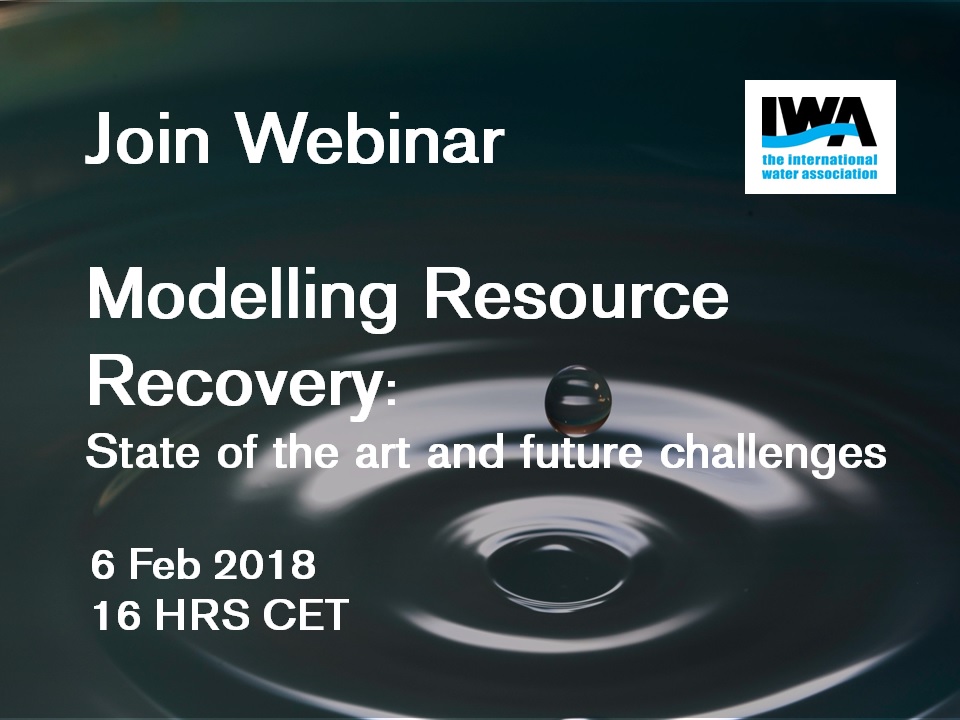
THE WEBINAR WAS HOSTED BY Ingmar Nopens (Ghent University, Belgium) and Ulf Jeppsson (Lund University, Sweden).
PANELLISTS
– Borja Valverde-Pérez (Technical University of Denmark, Denmark)
– Jean-Philippe Steyer (INRA, France)
– Kimberly Solon (Ghent University, Belgium)
– Lina Belia (Primodal, Canada)
– Céline Vaneeckhaute (Université Laval, Canada)
Modelling and Integrated assessment: Overcoming data issues and barriers to integrated modelling in practice
Sep 26, 2017 4:00 PM in CEST
This webinar discusses two common challenges in the application of modelling and integrated assessment.
The 1st topic of this webinar “Overcoming data issues in process modelling” discusses the challenges related to recognizing and obtaining good quality data. In fact, modellers spend a significant part of their time on data screening and collecting additional measurements instead of developing new models and providing solutions for process optimisation. Specific attention was paid to typical fault patterns and the selection of proper tools for their detection.
The 2nd topic “Integrated modelling in practice” aims to discuss the barriers that are preventing the application of an integrated model for decision support in urban water management. The webinar focused on the diverse nature of these barriers, provided some examples of potential strategies and introduced a systematic way to increase receptivity towards integrated models.
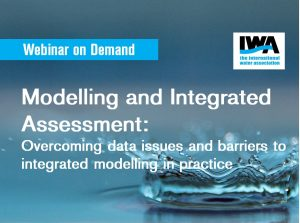
THE WEBINAR WAS HOSTED BY Ingmar Nopens (Ghent University, Belgium) and Ulf Jeppsson (Lund University, Sweden).
PANELLISTS
-
-
- Kris Villez (Eawag, Switzerland)
- Adrienne Menniti (Clean Water Services, USA)
- Peter Bach (Monash University, Australia)
- Lorenzo Benedetti (Waterways, Croatia).
-
All of them are members of IWA specialist group on Modelling & Integrated Assessment
Courses
COST Action Water 2000 e-course
In the framework of the COST Action Water 2020 (Conceiving Waste Water Treatment in 2020 – Energetic, environmental and economic challenges (ES1202)), an e-course on Micropollutants in Water has been prepared. The e-course is available here.
Advanced course on Modelling of Integrated Urban Drainage-Wastewater Systems
Wednesday 6th – Saturday 9th September 2017, Prague, Czech Republic.
DTU Environment and modelEAU, Université Laval, in collaboration with the Czech Technical University (Faculty of Civil Engineering), are happy to announce the fourth edition of the advanced course on Modelling of Integrated Urban Drainage-Wastewater Systems.
After the previous editions held in Copenhagen (Denmark), Quebec City (Canada), and Lyon (France), this year the course will be held in Prague (Czech Republic) in the days before the 14th ICUD conference (www.icud2017.org). This will give the opportunity to all the ICUD participants to follow the course (but you do not need to attend ICUD to follow the course).
The physical part of the course will be held at CTU campus from Wednesday 6th (afternoon) to Saturday 9th September. The course will also have an e-learning part, starting on 14th August.
The course is targeted at practitioners, PhD students, and researchers modelling the elements of integrated Urban Drainage-Wastewater systems – drainage network, wastewater treatment plants, receiving water bodies. The course consists of an overview of state-of-the-art tools for integrated modelling of urban drainage and wastewater systems, simulation exercises based on the WEST® software, and examples of application of integrated approaches for improving the environmental status of natural water bodies.
Students will be awarded a total of 2.5 ECTS by the Technical University of Denmark after the completion of the course.
Additional information (detailed course content, prices, practical information) can at DTU Environments homepage (https://goo.gl/JD2eCi ). Please contact the course responsible (Dr. Luca Vezzaro – luve@env.dtu.dk) for any further question.
